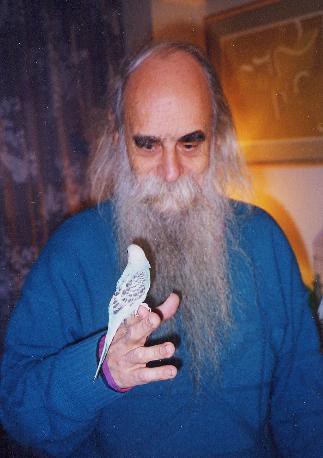Every once in a while, a scientist comes along who leaves an impression on the field so strong that all of the subsequent work on uses their results as a starting point, as a foundation. Einstein did that with relativity; Dirac did that with relativistic quantum mechanics; even Newton did that with mechanics.
 Image credit: Claude Lovelace with Parakeet (courtesy of Rutgers), via http://www.physics.rutgers.edu/people/images/Lovelace_H.jpg.
Image credit: Claude Lovelace with Parakeet (courtesy of Rutgers), via http://www.physics.rutgers.edu/people/images/Lovelace_H.jpg.
But what about when the person who does that is someone you've never heard of? Thanks to our new writer Paul Halpern, that story is about to come to light.
Go learn the story of Claud Lovelace, the person who brought theoretical physics beyond four dimensions and firmly into higher-dimensional space!
- Log in to post comments
More like this
"There is a fifth dimension, beyond that which is known to man. It is a dimension as vast as space and as timeless as infinity." -Rod Serling
It's been an action-packed week here on Starts With A Bang, and we've tackled a whole slew of topics you're unlikely to see anyplace else! The past week has…
"You do not become good by trying to be good, but by finding the goodness that is already within you, and allowing that goodness to emerge." -Eckhart Tolle
We're really hitting our stride for 2015 here at Starts With A Bang, and I'm so pleased you shared this past week with me. If you missed…
"Computers don't make mistakes. What they do, they do on purpose." -Dale Gribble, King of the Hill
Alright, so I know you're all impatient with the most burning Starts With A Bang! question of all: what was Ethan for Halloween? Well, without further ado, I'd like to introduce you to my avatar for…
“Weightlessness was unbelievable. It's physical euphoria: Nothing about you has any weight. You don't realize that you are weighed down all the time by yourself, and your organs, and your head. Your arms weigh down your shoulders. In space simulation, you get to fly like Superman! You're hanging in…





The article says " (In addition to scholarly papers about tachyons, Benford also wrote a short story called the “Tachyonic Anti-telephone” about causality violations through backwards-in-time communication.)"
Benford wrote an entire book (Timescape) based on this premise. It won the Nebula award for best novel in 1980.
Gregory Benford wrote a novel about communication across time as well, called (IIRC) 'Timescape'.
Yes, of course, Benford wrote Timescape too with the premise of backward communication in time. Thanks, Eric & Bruce for pointing that out. I mentioned the earlier story because it was published closer in time to the period discussed in the article.
I have a short Amazon book "The Mental Creation of Time". It's a relationist (i.e., all physical events are more fundamental than time) argument that ultimately time is an emergent dimension of mind. Cures the block-univ. delusion. Please go and see the summary.
Have a question about no. dimensions. Having not dug too deep in string theory, last I heard, it was "agreed" on 10 or 10+1 dimensions. I really can't remember which two solutions were in question. It was some 2-3 years ago.
Having said that, and article pointing at unity at 26 dimensions, what is the current view today? 10-11 or 26. Do 10-11th solution suffer from lack of unity, or was some advancement made to reduce 26 to 10-11?
@5 - from Ethan's article, it appears that modern string theory is trying to resolve a different problem than Lovelace was trying to resolve. So it was 26 needed for Lovelace's problem (which has since been solved by the discovery of quarks, rendering a 26-dimensional space unnecessary), and 10-11 needed for modern string theory.
It's actually Mr Paul's article :) But I understand what you're saying, that makes sense. Thanx :)
I really liked the article. It nicely covered the spiritual desire to have a unified theory and the necessity to go beyond what is just readily seen. The unified theory may not bring any ready comercial use, but it needs to be looked for.
I am a young aspiring theoretical physicist who anticipates enrolling at Rutgers University. I came across Professor Lovelace's brief research interest overview and was intuitively drawn to his overview over the other professors' various and similar expressions (found here: http://www.physics.rutgers.edu/grad/redbook10/Red-www-HET.html) listed in the "Handbook for Physics Graduate Students", which is the latest online version of the handbook. I tried to find contact information of Prof. Lovelace only to be led to this article that he passed away. I am even more drawn to his research and am determined to pursue his similar thought and collaborate (when I gain my 'mathematical maturity') with others who share similar interests.
Dr. Paul Halpern, I understand you are a professor at the University of Sciences of Philadelphia. Where does your research interest lie? I assume you are interested in string theory based on the this well written article. I look forward in studying your books and articles for the development of my armaturish theory that was conceived shortly before my reading of this. I hope to attend conferences and congresses not only that APS holds, but obtaining possible memberships of national and international centers and societies of mathematical and computational physics. For in my opinion, it is never to early to immerse oneself into what his aspirations lie.
In conclusion, I want to thank you for writing this article it truly fueled my determination to the exponential degree.
Anyone who has found inspiration in this article, or shares simular thoughts feel free to email me at dre.xzvr@gmail.com
I've heard of Linda Lovelace and Ada Lovelace but never came across this guy before. Great article!! Amazing how such productive people can remain hidden from public view for so long.